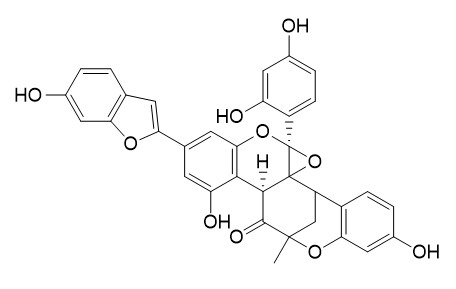Mulberrofuran Q
Mulberrofuran Q may protect neuronal cell death against the oxidative stress induced by oxygen-glucose deprivation (OGD).
Inquire / Order:
manager@chemfaces.com
Technical Inquiries:
service@chemfaces.com
Tel:
+86-27-84237783
Fax:
+86-27-84254680
Address:
1 Building, No. 83, CheCheng Rd., Wuhan Economic and Technological Development Zone, Wuhan, Hubei 430056, PRC
Providing storage is as stated on the product vial and the vial is kept tightly sealed, the product can be stored for up to
24 months(2-8C).
Wherever possible, you should prepare and use solutions on the same day. However, if you need to make up stock solutions in advance, we recommend that you store the solution as aliquots in tightly sealed vials at -20C. Generally, these will be useable for up to two weeks. Before use, and prior to opening the vial we recommend that you allow your product to equilibrate to room temperature for at least 1 hour.
Need more advice on solubility, usage and handling? Please email to: service@chemfaces.com
The packaging of the product may have turned upside down during transportation, resulting in the natural compounds adhering to the neck or cap of the vial. take the vial out of its packaging and gently shake to let the compounds fall to the bottom of the vial. for liquid products, centrifuge at 200-500 RPM to gather the liquid at the bottom of the vial. try to avoid loss or contamination during handling.
Ecol Evol.2022, 12(11):e9459.
Food Chemistry: X2023, 101032.
Asian Journal of Chemistry2014, 26(22):7811-7816
J Ethnopharmacol.2022, 289:115018.
J Appl Biol Chem.2024, 67:33,238-244
J Ginseng Res.2023, 47(4):593-603.
Talanta.2022, 249:123645.
Int J Cosmet Sci.2019, 41(1):12-20
Indian J. of Experimental Bio.2020, 9(58).
Dermatologica Sinica2024, 42(1):p19-30.
Related and Featured Products
Arch Pharm Res. 2012 Jan;35(1):163-70.
Protection of prenylated flavonoids from Mori Cortex Radicis (Moraceae) against nitric oxide-induced cell death in neuroblastoma SH-SY5Y cells.[Pubmed:
22297755]
METHODS AND RESULTS:
Seven prenylated flavanoids, licoflavone C (1), cyclomulberrin (2), neocyclomorusin (3), sanggenon I (4), morusin (5), kuwanon U (6) and kuwanon E (7), and three 2-arylbenzofurans, moracin P (8), moracin O (9), and Mulberrofuran Q (10) were isolated from the MeOH extract of Mori Cortex Radicis. Among these, compounds 2-7 enhanced cell viability in a dose-dependent manner against sodium nitroprusside-induced cell death in neuroblastoma SH-SY5Y cells, which was measured by MTT reduction assay (EC(50) values of 4.4, 5.6, 8.0, 6.4, 8.7, and 11.9 μg/mL, respectively). Among 10 compounds, C-3 prenylated flavones (2, 3, and 5) and prenylated flavanones (4, 6, and 7) showed cell protection. However, compound 1 which lacks the prenyl group at C-3 and three 2-arylbenzofurans (8-10) did not show protective effect. The order of cell protection was as follow: C-3 prenylated flavones (2, 3, and 5) > prenylated flavanones (4, 6, and 7) > 2-arylbenzofurans (8-10) and flavone (1).
CONCLUSIONS:
From this result, we show that some prenylated flavones and flavanones might protect neuronal cells against nitrosative stress-mediated cell death. Even though further evaluations are necessary in vitro and in vivo study, we carefully suggest that some prenylated flavonoids from Mori Cortex Radicis might protect neuronal cells from neurodegenerative diseases.
Arch Pharm Res. 2011 Aug;34(8):1373-80.
Inhibitory effect of 2-arylbenzofurans from the Mori Cortex Radicis (Moraceae) on oxygen glucose deprivation (OGD)-induced cell death of SH-SY5Y cells.[Pubmed:
21910060]
METHODS AND RESULTS:
Three known 2-arylbenzofurans, moracin P (1), moracin O (2) and Mulberrofuran Q (3) were isolated from the MeOH extract of the Mori Cortex Radicis. These compounds 1-3 enhanced cell viability in dose-dependent manner against oxygen-glucose deprivation (OGD)-induced cell death in neuroblastoma SH-SY5Y cells, which was measured by MTT reduction assay. (EC(50) values of 10.4, 12.6, and 15.9 μM, respectively). In addition, the compounds 1-3 were examined for their inhibitory effect on OGD-induced ROS production by FACS analysis. We observed these compounds reduced ROS production in OGD-induced cell death (IC(50) values of 1.9, 0.3 and 12.1 μM, respectively). Consequently, reactive oxygen species (ROS) were overexpressed in OGD-induced cells and all three compounds reduced ROS induced by OGD in dosedependent manner.
CONCLUSIONS:
Taken together, compounds 1-3 might protect neuronal cell death against the oxidative stress induced by OGD, though further studies in vitro and in vivo models are necessary.
Zhongguo Zhong Yao Za Zhi. 2009 Feb;34(3):286-90.
Study on Diels-Alder type adducts from stem barks of Morus yunanensis.[Pubmed:
19445150]
To isolate and identify the Diels-Alder type adducts from stem barks of Morus yunanensis.
METHODS AND RESULTS:
The compounds were isolated and purified by silicagel, Sephadex LH-20 and RP-18 colum chromatography. Their chemical structures were elucidated on the basis ofphysicochemical properties and spectral data.
Nine compounds were isolated and identified as: kuwanon G (1), sanggenol M (2), mulberrofuran J (3), guangsangon B (4), resveratrol (5), kuwanon X (6), kuwanon P (7), mulberrofuran O (8), Mulberrofuran Q (9).
CONCLUSIONS:
All the compounds are isolated from the plant for the first time, and compounds 4, 5 have anti-inflammation activities with inhibitory ratios of 57.3%, 50.5% respectively at a concentration of 10 microg mL(-1).



